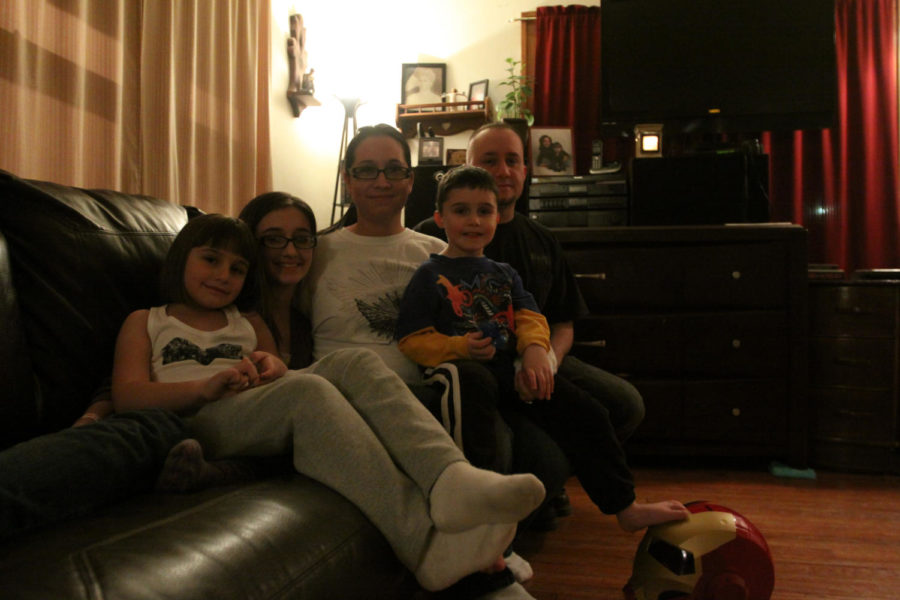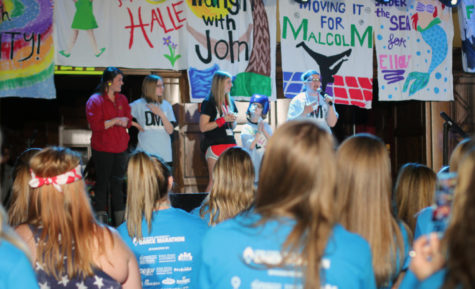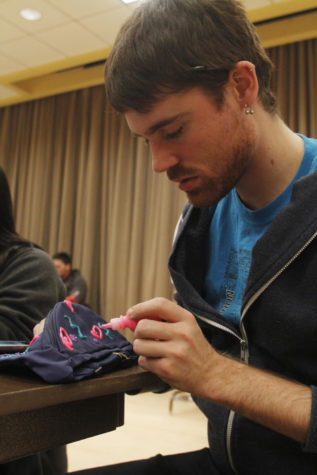Dance Marathon: Troy’s uphill battle with disease
Photo: Huiling Wu/Iowa State Daily
Troy Ramsey was diagnosed with toxic synovitis when he was one. The Ramsey family joined Dance Marathon in 2011 while they were in Iowa City. They say they get a sense of hope by participating.
January 19, 2012
Within a three month period, 2-year-old Troy Ramsey went from being a healthy toddler learning how to walk to a barely functioning paraplegic on the verge of death.
In December of 2008, Troy was experiencing pain in his hips and was taken to the doctor to determine what was causing the toddler pain.
“Originally the doctor told us there was nothing wrong with him, that he was just constipated and he would be okay soon,” said Amanda Ramsey, mother of 4-year-old Troy. “But within a two week period he had gone from just having learned how to walk, to limping, to only being able to sit up. Finally he got to the point where he was barely able to sit up, he was in that much pain.”
That was two years ago. Now Troy can sit, stand, jump, and run just like all his friends. However, it was not an easy road to get to this stage, for Troy or his family.
At Blank Children’s Hospital, he was originally diagnosed with toxic synovitis.
Toxic synovitis is “a condition affecting children that causes hip pain and limping,” according to the United States National Library of Medicine.
After doing more testing on Troy, doctors found this diagnosis was incorrect. The only problem was, they did not know what he had, even with multiple visits and tests.
“They had seen us there so much,” said Marshall, Troy’s father. “I really thought he was going to die, seeing him in so much pain. I had just about given up. I was so scared.”
After figuring out their diagnosis was incorrect, doctors at Blank Children’s diagnosed Troy with having discitis, also known as inflammation of the inverterbral disc or disc space. A Peripherally Inserted Central Catheter, also known as a PICC line was inserted into Troy’s arm in order to get the antibiotics he was on directly to his heart.
A home nurse was sent to the Ramsey house to come and check the blood levels and flush and dress his PICC line each week. During one of the visits, some of the stitches were accidentally ripped out of Troy’s arm. When that happened the PICC line came out partially. The nurse felt that rethreading the line would be fine because not much of the line was exposed. A few days later when the skin started to heal, it started to itch. With the itching Troy proceeded to rip the rest of the stitches out and pulled out the PICC more.
“I had to rush him to the ER as the PICC goes into the main artery and blood was now flowing very freely,” Amanda said. “My oldest daughter, Michaela, had to hold a tourniquet on his arm while I drove. At the ER they cleaned the site and rethreaded the PICC and said that would be fine.”
Two surgeries were scheduled then canceled by doctors and the PICC line was rethreaded several times before things got really bad.
One day Troy’s skin started breaking out in a rash.
“His skin was just filled with hives, red bumps and pus everywhere,” Marshall said.
Troy was again rushed to the ER where doctors said he was breaking out in hives due to the high amount of medications and skin irritation. Then they sent Troy to a dermatologist who said the same thing.
The Ramsey family decided something needed to be done. Marshall’s sister suggested they try seeing a doctor in Iowa City to see if Troy could be correctly diagnosed. She called the University of Iowa Hospital and told them about Troy. The doctors immediately called the Ramsey’s to bring Troy in as soon as possible.
“It was literally minutes after we got home from the dermatologist that my sister-in-law called us, and said she got into contact with some of her friends at UICH and that we should be expecting their call,” Amanda said. “A few minutes later they called us and asked us to please bring him to them and that they would start over fresh.”
The Ramsey family arrived in just the nick of time. Troy’s rash had not been caused by his medications, but instead had been a result of septic shock.
Septic shock is a serious condition that occurs when an overwhelming infection leads to life-threatening low blood pressure, according to the USNLM. Any type of bacteria can cause septic shock. Fungi and, rarely, viruses may also cause the condition. Toxins released by the bacteria or fungi may cause tissue damage, and may lead to low blood pressure and poor organ function.
If they had arrived merely two hours later, Troy likely would have died.
“When we got there, they had at least three professionals from every team (rheumatology, oncology, infectious disease, neurology and hematology) in Troy’s room,” Amanda said. “They were so shocked. They could not figure out what was wrong with him. Nobody knew what to expect.”
After going through another series of tests, doctors finally figured out in January of 2010 what was ruining Troy’s life. Troy had spondylodiscitis.
Spondylodiscitis is an inflammation of the base and upper plates of the spine vertebra as well as the intervertebral disc.
“The spondylodiscitis was the result of a staph infection settling into his spine,” Amanda said. “The L3, L4 and L5 were the vertebrae affected. Normally you would never see this in a child this young. Normally this is something that 60-year-olds have. It was definitely really scary. No one his age had contracted this, and we didn’t know what to expect.”
While performing an MRI, doctors also found out that Troy also had an arachnoid cyst in his brain. According to the National Institute of Neurological Disorders and Stroke, arachnoid cysts are “cerebrospinal fluid-filled sacs that are located between the brain or spinal cord and the arachnoid membrane, one of the three membranes that cover the brain and spinal cord.”
After everything they had been through all Marshall could think was “‘geez, when is this kid gonna catch a break?'”
While the Ramsey family was in Iowa City, Iowa State’s Dance Marathon contacted them about participating. At first hesitant to join, the Ramsey family declined to go to Dance Marathon in 2010. However, in 2011 they decided to try it out and attended for their first time.
“We just thought ‘do we deserve to go?'” Amanda said. “I mean, we thought, our child does not actually have cancer. But they said no, any miracle baby can come. It was really neat and amazing. I thought it was just so awesome how much time the kids give to this cause especially with all the other events they do throughout the year. They are 100 percent into the kids.”
Marshall felt the same way. “It really gave me a sense of hope. On the news you see all this negative stuff about college finances going up, and kids running away from college. But here you saw all this good character. This is the next batch of good kids.”
Jody Feipel, senior in kinesiology and health, and families co-director of ISU Dance Marathon has been in DM for three years. She met the Ramsey family in December of 2010 and since then has become a consistent DM contact for the Ramsey’s.
“All of the countless hours that I and the rest of my fellow executive council members have spent preparing for this huge event are worth everything to these children who are our miracles,” Feipel said. “You may have a hard time seeing it from the outside, but once you set foot in the Great Hall on Jan. 21, you will feel the love, fun and passion for helping children. Hearing Troy’s story is just one of the many that brings a smile to my face because I know that I was a part of his miracle, and I hope you are, too.”
Troy’s condition has improved, but there are occasional hiccups. In 2011 right before Dance Marathon, the doctors informed his parents that the cyst in his brain was growing. During his most recent MRI in May 2011, they discovered the three vulnerable vertebrae in his spine were fusing together.
“Those really affect mobility,” Amanda said. “But, since he’s still growing there’s a chance that his body will just adapt to the changes as it grows. Right now all we can do is sit and wait.”
The big red flag, Marshall said was “if we see him lose mobility at all in his right side. We’re told to get him to the doctors in Iowa City right away. He’s the biggest ham ever though. It’s amazing what all he has been through and now he’s doing all that,” pointing at Troy playing with his sisters.
Now the Ramsey’s are enjoying their time with Troy, constantly watching for neurological and physical signs of anything wrong and appreciating that he is finally able to be pain free again.













